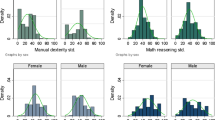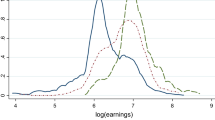Abstract
This paper is concerned with the English-language requirements of occupations in the USA, as measured by the O*NET database. These scores are linked to employed native and foreign-born men in the 2000 Census. Earnings increase with the respondent’s proficiency in English, with the English proficiency required for the occupation, and when those with high levels of proficiency work in jobs requiring English-language skills (interaction effect). There is a strong economic incentive for the matching of worker’s English skills and the occupation’s requirements, and this matching tends to occur in the labor market.



Similar content being viewed by others
Notes
In the words of Heckman et al. (2003), “the Census data used in this paper yield large samples but few instruments.”
The use of PROF i in this regard follows from suggestions by a referee. It is consistent with the overall approach of the study.
The National O*NET Consortium was organized to develop O*NET and its related products for the US Department of Labor Employment and Training Administration (ETA). The Consortium currently comprises the O*NET Management Partnership (the North Carolina Employment Security Commission, the Center for Employment Security Education and Research, and the ETA) and the National O*NET Support Group (composed primarily of the National Center for O*NET Development, the Research Triangle Institute, and the Human Resources Research Organization). Web address of O*NET data: http://online.onetcenter.org.
Findings from the analyses based on the importance of English are presented in a Statistical Appendix, available from the authors upon request.
The O*NET database version 12.0 contains a crosswalk between the SOC that forms the basis of the Census codes and the O*NET codes. Three hundred sixty-nine of the 509 Census 2000 occupational categories exactly match SOC categories, 127 match at a broader level, and 13 are aggregates of SOC categories.
The payoff to potential labor market experience is 2.3% for the native born and 1.0% for the foreign born, when evaluated at 10 years. Similar results are documented by Chiswick and Miller (2008), where the payoff to potential labor market experience in the absence of control for the occupational English requirements was reported to be 2.3% for the native born and 0.8% for the foreign born.
Including the ER i variable in the estimating equation in quadratic form does not alter the findings: the results show that earnings increase at a decreasing rate with the English requirements of jobs for the native born: \(1.964\mbox{ER}_i -0.690\mbox{ER}_i^2\) and at an increasing rate for the foreign born: \(0.935\mbox{ER}_i +0.649\mbox{ER}_i^2\). All coefficients were statistically significant. The other estimates in the model were largely unaffected by the inclusion of the squared ER i variable.
Related to this, the partial effect of education on earnings in the IV estimation (not reported in Table 2) is very small: 2% for the native born and 1% for the foreign born. This is further reason for focus on the OLS results.
While the Census occupational categorization has 509 codes, there are several occupations that are not represented in the sample used. Included in this group are the military occupations for which the O*NET database does not collect information.
References
Borjas G (1994) The economics of immigration. J Econ Lit 32(4):1667–1717
Chiswick BR, Miller PW (1992) The immigrant experience in Canada and the United States. In: Chiswick BR (ed) Immigration, language and ethnic issues: Canada and the United States. American Enterprise Institute, Washington DC, pp 229–296
Chiswick BR, Miller PW (1995) The endogeneity between language and earnings: international analyses. J Labor Econ 13(2):246–288
Chiswick BR, Miller PW (2007) The economic cost to native-born Americans of limited English language proficiency. In: Chiswick BR, Miller PW (eds) The economics of language: international analyses. Routledge, London, pp 413–430
Chiswick BR, Miller PW (2008) Why is the payoff to schooling smaller for immigrants? Labour Economics (in press)
Dickens WT, Katz LF (1987) Inter-industry wage differences and industry characteristics. In: Lang K, Leonard JS (eds) Unemployment and the structure of labor markets. Basil Blackwell, New York USA, pp 48–89
Duncan OD (1961) A socioeconomic index for all occupations. In: Reiss AJ Jr (ed) Occupational and social status. Free Press, New York, pp 109–138
Fry R, Lowell BL (2003) The value of bilingualism in the US labor market. Ind Labor Relat Rev 57(1):128–140
Groshen EL (1991) Sources of intra-industry wage dispersion: how much do employers matter? Q J Econ 106(3):869–884
Gyourko J, Tracy J (1988) An analysis of public- and private-sector wages allowing for engogenous choices of both government and union status. J Labor Econ 6(22):229–253
Hartog J, Oosterbeek H (1993) Public and private sector wages in the Netherlands. Eur Econ Rev 37(1):97–114
Heckman JJ, Lochner LJ, Todd PE (2003) Fifty years of mincer earnings regressions. NBER Working Paper No. 9732
Johnson G, Solon G (1986) Estimates of the direct effects of comparable worth policy. Am Econ Rev 76(5):1117–1125
Meng X, Gregory RG (2005) Intermarriage and the economic assimilation of immigrants. J Labor Econ 23(1):135–175
Moulton BR (1986) Random group effects and the precision of regression estimates. J Econom 32(3):385–397
Acknowledgements
We thank Derby Voon for research assistance and three anonymous referees for helpful comments. Chiswick acknowledges research support from the Smith Richardson Foundation and the Institute of Government and Public Affairs, University of Illinois. Miller acknowledges financial assistance from the Australian Research Council.
Author information
Authors and Affiliations
Corresponding author
Additional information
Responsible editor: Klaus F. Zimmermann
Appendix A Description of variables
Appendix A Description of variables
The variables used in the statistical analyses are defined below. Mnemonic names are also listed where relevant.
1.1 Data source
2000 US Census of Population, 1% Public Use Microdata Sample; O*NET Occupational data from the O*NET Consortium described in footnote 1.
1.2 Definition of population
Native-born and Foreign-born men aged 25 to 64 in the 50 States and the District of Columbia.
1.3 Dependent variable
1.3.1 Earnings
The natural logarithm of the individual’s annual earnings from wage and salaried employment or self-employment for 1999.
1.4 Explanatory variables
1.4.1 Educational attainment (EDUC)
The total years of full-time equivalent education. The following values are assigned to the Census categories: completed less than fifth grade (2 years); completed fifth or sixth grade (5.5); completed seventh or eighth grade (7.5); completed ninth grade (9); completed tenth grade (10); completed 11th grade (11); completed 12th grade or high school (12); attended college for less than 1 year (12.5); attended college for more than 1 year or completed college (14); Bachelor’s degree (16); Master’s degree (17.5); Professional degree (18.5); Doctorate (20).
1.4.2 Labor market experience (EXP)
A measure of potential labor market experience, computed as age - years of education - 6.
1.4.3 Log weeks worked (WEEKS)
The natural logarithm of the number of weeks the individual worked in 1999.
1.4.4 Years since migration (YSM)
This is computed from 2000 minus the year the foreign-born person came to the USA to stay.
1.4.5 English-language fluency
Three dichotomous variables that distinguish individuals who speak a language other than English in the home and who speak English either: (1) “Very Well”; (2) “Well”; (3) “Not Well”/“Not at All”. The benchmark group is those who speak only English at home.
1.4.6 Race (BLACK)
This is a dichotomous variable, set to one if the individual is black and set to zero for all other racial groups.
1.4.7 Marital status (MARRIED)
A dichotomous variable that distinguishes individuals who are married, spouse present (equal to 1) from all other marital states.
1.4.8 Location
The two location variables record residence in a non-metropolitan area (NON-MET) or in a Southern State (SOUTH). The states included in the latter are: Alabama, Arkansas, Delaware, District of Columbia, Florida, Georgia, Kentucky, Louisiana, Maryland, Mississippi, Missouri, North Carolina, Oklahoma, South Carolina, Tennessee, Texas, Virginia, West Virginia.
1.4.9 Veteran (VETERAN)
This is a dichotomous variable, set to one if the individual is veteran of the US Armed Forces, and set to zero otherwise. Those currently in the military are excluded from the sample.
1.4.10 English requirements (LEVEL and IMPORTANCE)
These variables record the scores for the level and importance of English requirements for each occupation obtained from the O*NET database. When the O*NET database was first developed, job analysts relied on information from the Dictionary of Occupational Titles and modified this to suit the set of occupational codes (Standard Occupational Classification System) used in O*NET. Since June 2001, data have been collected from workers in targeted subsets of the occupations identified in O*NET, using a two-stage sampling design based on random samples of workers in targeted occupations within a random sample of businesses. These survey data have been progressively integrated into the initial O*NET database. This study used version 12.0 released in September 2007. Nearly all of the occupational language requirements are based on worker assessments for their occupation. There are no data in O*NET on military occupations.
Rights and permissions
About this article
Cite this article
Chiswick, B.R., Miller, P.W. Occupational language requirements and the value of English in the US labor market. J Popul Econ 23, 353–372 (2010). https://doi.org/10.1007/s00148-008-0230-7
Received:
Accepted:
Published:
Issue Date:
DOI: https://doi.org/10.1007/s00148-008-0230-7




